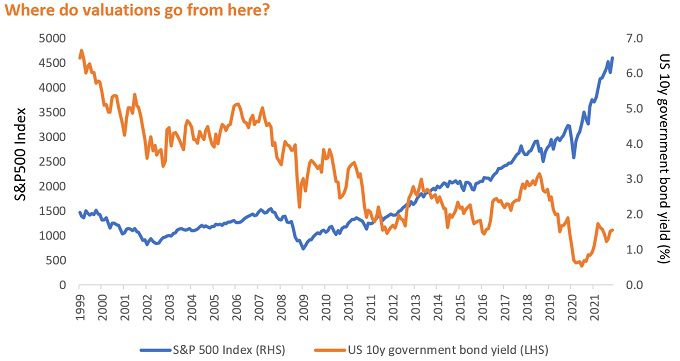Alternatives 2022: has the bull gone far enough?

5 minute read
David Elms, Head of Alternatives at Janus Henderson, looks ahead to 2022 and considers the value of an allocation to truly diversified strategies after a year of record-breaking market highs.
Key takeaways:
- There is an enormous amount of speculation built into markets, yet diversification, it seems, has been a choice for the faint hearted.
- As we enter 2022, we see the inflation and interest rates as two areas that we believe could ultimately cause risk assets to re-price.
- Alternatives offer a fundamentally different prospect than more traditional strategies built around equities or bonds – that difference is perhaps the biggest opportunity for the asset class.
What themes do you see as relevant to alternatives in 2022?
If I were going into battle, I would like this market on my side. It has been bulletproof. It does not matter what has been thrown at it. Record valuations? It is a new paradigm, a modern industrial revolution which will underpin spectacular earnings growth. Inflation? It is transient and supply side driven; interest rates will stay benign for ever. Geopolitical posturing towards Taiwan and Ukraine? Government debt? New COVID variants? Is Bitcoin worth US$1 trillion…?
The questions in the arsenal of the market bears are indeed impressive enough to warrant pause for thought. Yet still, markets have continued to plough onwards and upwards, hardly battle scarred, investors seemingly inured to risk and steadfast in their allocation decisions. Indeed, at the time of writing, the S&P 500 Index has posted all-time closing highs on over 70 days thus far in 2021. There is an enormous amount of speculation built into markets, yet diversification, it seems, has been a choice for the faint hearted.
Is there a chink in the armour?
We have certainly been surprised at just how strong equity markets have been in 2021; market optimism has been, at times, seemingly ironclad. The question over what will fundamentally break this seemingly unstoppable force is a tough one to answer. As we enter 2022, we see the risk of a policy mistake by central banks as the most significant obstacle for markets, with regards to both equities and credit. With the duration of some parts of the equity market so stretched, even a small rise in interest rates could have a significant impact on valuations. Likewise, while credit spreads (the difference in yield between government bonds and other, lower quality bonds) remain at all-time tight levels, suggesting that investors are not getting much reward for taking additional risk, we are starting to see cracks appear as some countries try and reign in stimulus measures.
The ingredients are certainly there that could underpin long-term demand for alternative strategies with diversified performance drivers and low correlation to either equities or bonds. For as long as real rates remain negative, however, the attraction of risk assets could remain strong. More recently, the emergence of the new ‘Omicron’ COVID variant has created some uncertainty. It will evolve, but the question is now turning towards whether it could drive another round of stimulus.
Where are you seeing the biggest opportunities for alternatives?
Alternatives offer a fundamentally different prospect for investors than more traditional core strategies built around equities or bonds – and that difference is perhaps the biggest opportunity for the asset class. Today, we see inflation and interest rates as two areas that we believe could ultimately undermine confidence, leading to a change in investor behaviour. While we have seen a few false starts on this view in 2021, they remain a source of vulnerability as we move into 2022.
Ultimately, the behaviour of markets is a sociological phenomenon, one that can be very hard to really predict. If you are an investor who is trying to time that market turn… that is very difficult thing to do. For us, it really highlights the need for a multi-layered approach to building a balanced portfolio. For a dedicated team working on alternatives, the breadth of differentiated approaches you can bring to bear makes you more adaptable. Expanding those capabilities creates more tools to help you adapt and reconfigure.
If you could sum up the current market environment in one chart?

The biggest takeaway for 2022? Recycle excess returns…
Given current market dynamics, we would argue that many investors have earned excess returns from their investments in risk assets, and that reinvesting some of those returns into diversifying strategies could represent a fundamental pillar of good investment management. Indeed, we see increasing demand for alternatives that have demonstrated little sensitivity to risk assets.
Diversification is always an important focus for us – not just diversification by asset class, but real diversification, in terms of the underlying drivers of performance. We see opportunities for adaptable investment propositions that can allocate between different strategies, deploying or withdrawing capital as market conditions change, or as specific investment opportunities become more or less crowded.
We think that there is a strong argument for investors to make more space for alternatives in their portfolios. Ultimately, it comes down to client experience. If you can deliver attractive, risk-adjusted returns with performance drivers that have little or no correlation to equities and bonds, or hedge funds, then you are likely to be far more useful to a client, should the current market environment turn more volatile, and uncertainty take hold.
These are the views of the author at the time of publication and may differ from the views of other individuals/teams at Janus Henderson Investors. References made to individual securities do not constitute a recommendation to buy, sell or hold any security, investment strategy or market sector, and should not be assumed to be profitable. Janus Henderson Investors, its affiliated advisor, or its employees, may have a position in the securities mentioned.
Past performance does not predict future returns. The value of an investment and the income from it can fall as well as rise and you may not get back the amount originally invested.
The information in this article does not qualify as an investment recommendation.
There is no guarantee that past trends will continue, or forecasts will be realised.
Marketing Communication.